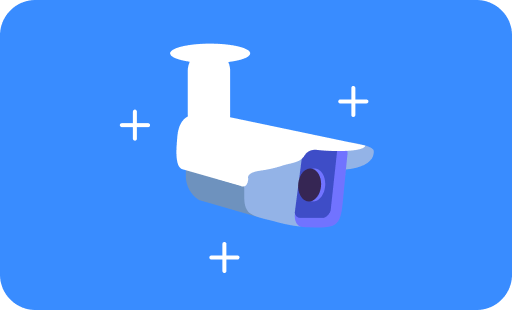How can the monitoring industry adapt to remote working?
- Physical security

With many businesses in lockdown around the world, we wanted to find a way to continue sharing knowledge remotely. So, in Calipsa’s first webinar, our CEO Mohammad Rashid Khan was joined online by three security experts to discuss how their surveillance businesses have had to adapt to the new remote working measures in place, from initial challenges to new ways of working.
Our speakers were:
- Ryan Schonfeld - CEO, RAS Security Group
- Warren Neuburger - CTO, EyeQ Monitoring
- Satyajeet Hoskote - VP of Product, Eyewitness Surveillance
Missed the live discussion? You can still watch the full webinar here. Don’t forget to join us on 15th April, 4pm BST when we’ll be looking at ‘How to reduce the strain on monitoring operators.’
Here’s what we learned from our talk, including the results of our attendee poll:
Security businesses are an essential service
The key challenge for security businesses in lockdown is how to keep an essential service running smoothly. While the majority of people are now working remotely, many video monitoring businesses have to keep their control rooms open, which is complicated from a health and safety standpoint, and from a legislative perspective.
Ryan Schonfeld and Warren Neuburger explained that in the US, local and federal governments have been inconsistent on what constitutes an essential worker, which means that security businesses are often overlooked; legislation varies from state to state, and even from city to city.
Eyewitness’s agents work around the world, so for Satyajeet Hoskote, “the situation is exponentially complicated, as each jurisdiction does different things.” All of our speakers said that the key to keeping their key workers in the control room was to regularly provide employees with up-to-date paperwork that should enable them to travel to work without any complications.
In Warren’s view, “it’s just like being a fireman, or a policeman, or a doctor. When you’re in these kinds of essential services, you don’t necessarily have that luxury to be any place, or decide not to go in today, because there are people who depend on you.” As with police and fire services, he added that security is a necessity because “it comes down to public safety.”
All our speakers’ customers needed their services more than ever, with all three saying they had seen a noticeable increase in requests to move from scheduled monitoring hours to 24/7 monitoring. According to Ryan, “customers are struggling with more and more occupied buildings becoming vacant, so there is a growing need to secure them with monitoring.” 
How do you keep a control room running in lockdown?
For video surveillance companies to continue monitoring for their customers - and especially with the rise in requests for 24/7 monitoring - control rooms have remained open with special measures in place.
At RAS, EyeQ Monitoring and Eyewitness, social distancing is taking place in various forms. For Ryan and Warren, this involves splitting the command centre into A and B teams who operate in shifts. If someone in one team becomes ill, then that team self-isolates and the back-up team of agents can step in to carry on monitoring. Satyajeet explained how his teams have been split over two separate locations, to further reduce the spread of infection. This involved setting up a new, separate control room a few streets away.
Other measures include keeping staff distanced in the control room with remote support, use of multiple rooms, temperature checks, and no eating near equipment to limit saliva spread. At EyeQ Monitoring, Warren described how they have also set up new scheduling and clocking-in systems for their staff, which gives employees more flexibility: “pushing some of those capabilities out of management and into the hands of the agents themselves… creates a better work environment where they’re more in control of their own time usage.”
However, with reduced staff numbers in the control room, having as many agents as possible is crucial to maintaining consistent service and security levels - which means more remote workers.
How do you replicate the efficiency and effectiveness of a control room remotely?
According to Satyajeet, “it’s a balancing act. Yes we can go remote, but there are some efficiency and effectiveness metrics that might suffer - so can we control those? Those are two key elements that we need to stay on top of.”
All of our speakers agreed that connectivity was the primary focus of remote monitoring - specifically, how to get around the challenge of agents not being in the same room together. At Eyewitness, moving everyone onto the same online platform was a small improvement that significantly improved connectivity. Once everyone started communicating on the same platform, worries about response times, efficiency and effectiveness were reduced.
The camaraderie of a control room is also difficult to maintain remotely, so all our speakers spoke about the need to keep up staff morale. Ryan and Satyajeet described how at RAS and Eyewitness, teams have had remote lunches, or remote drinks after work, to encourage everyone to stay connected.
Delegation is also important. Even if everyone can’t be in the same room, having more experienced supervisors collaborating with agents as much as possible on chat platforms and voice calls “maintains the presence that is so critical in responding to events effectively”, as Ryan put it.
Still, it can be hard to replicate the immediacy of a physical control room remotely, and this could negatively impact response times. Warren explained: “As more people work from home, internet bandwidth is throttled, and you can get choppy performance which leads to delays. A delay of 5-7 seconds is a big deal, so we are moving into remote work very carefully.”
Is it 100% secure to set up remote agents/operators?
For overall security, having a control room will always be the best option. When all your operators are based in one command centre, companies have much greater control over the information flowing in and out.
Technology is in place for remote agents to securely log in and work remotely, but for Warren it doesn’t stop here. With plenty of experience implementing GDPR in previous roles, he feels that data security is a weak spot for many security businesses: “you have to start thinking about security on top of our normal operation, and remote brings a set of challenges that I don’t think our industry has really thought about before.”
For Warren, full data security involves anonymisation of customer information, so that even the remote agents don’t know exactly who it is they are monitoring. The software currently in use isn’t set up for anonymisation, so this is a challenge he believes the security industry will have to tackle as remote working becomes more prevalent.
When remote agents are contractors and not company employees, there are additional security challenges. Ensuring your remote workers have similar levels of expertise and experience as your in-house employees is difficult, but necessary, when it comes to maintaining service and security levels.
Warren continues, “if you want to get a remote workforce on your systems it brings additional constraints you may not have had before, like remote training, in order to bring those agents up to the same levels as your people on-site. You need to get good qualified individuals who know how to handle alarms and deal with police activity.”
However, the future of remote working still looks positive. Our speakers all felt that new technology, analytics and AI, such as Calipsa’s False Alarm Filtering Platform, will help agents to become much more effective wherever they are based. 
What can businesses learn from this period of remote working?
While being in lockdown is an uncertain time for us all, our speakers agreed that there are many lessons to be learned from this period of mass remote working that we can take with us moving forward.
Ryan said, “It’s forcing organisations to look at security if it’s something they’ve put off before, and look at things they’ve been doing the same way for a long time, to consider making changes. If not to become fully remote, then at least some kind of hybrid approach, which will affect security both physically and from a cyber perspective.”
“The economic challenges that companies face now will drive the need to increase efficiencies and save costs. The reality is, technology and monitoring services can be a huge cost saving to an organisation’s security programme. So I think that will drive adoption of remote working, and the services and technologies that enable it.”
Satyajeet saw this period as a time to make some positive changes: “From an operational perspective, we have a lot to learn from this experience. Certain parts of our business are very high touch, with people managing many aspects of our customer relationships. This time gives us a chance to look at how we do things, and to investigate how automation can help.”
“Changing habits takes time, and usually you don’t get that time to make significant changes. We’ve got a good chunk of time now where we can try new ways of doing business with customers as well as new ways of operating internally, where they will hopefully become habits. I see that as a huge benefit, that we could come out of this more operationally efficient.”
So what does this mean for monitoring companies? Ryan believes that in the current climate, particularly with increased 24/7 monitoring, control rooms could see greater demand. “Monitoring companies should come out of this positively. Not only should this period see a growing need for these services, it should also put people in the mindset that if they didn't have remote monitoring previously, they probably need it now.”
Thanks again to our speakers for sharing their time and expertise with us! If you’d like to watch the full webinar, click here. Or to view our infographic in full, click here.
Join us on 15th April, 4pm BST when we’ll be discussing ‘How to reduce the strain on monitoring operators.’







No comments